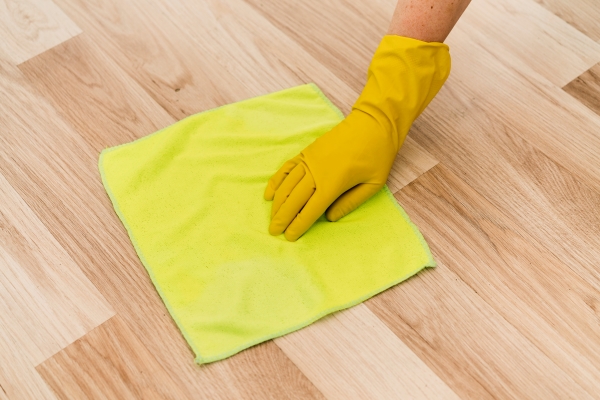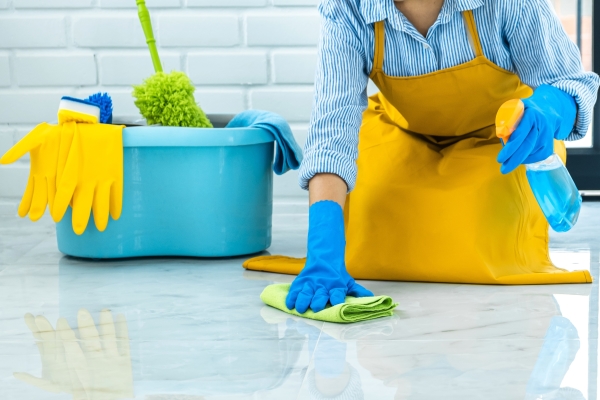No one wants a grimy, dirty floor. It’s not only unappealing but can also pose a safety hazard. If you’ve had a spill on your floor, it’s crucial to clean it up promptly. In this blog post, we’ll explore how to remove dirt, oil, and grease from your floor. We’ll provide step-by-step instructions so you can restore your floor to its clean and shiny state in no time!
Your floors are a vital component of your living space. Beyond providing a stable surface for movement, they play a key role in the overall aesthetic of your environment. Proper floor maintenance requires specific tools, items, and techniques. These depend on the type of dirt or residue you’re dealing with and the kind of flooring material you have.
This post will guide you through various stain removal techniques and tools suitable for different floor types, from wooden floors to hardwood ones. By the end of this post, you’ll have the knowledge to eliminate mud and stubborn dirt stains using household items.
## Essential Tools and Materials You’ll Need
Before cleaning your wooden floors, it’s essential to gather the appropriate cleaning tools and household materials. Here are some basic tools and items you’ll need to remove dirt effectively.
### Dish Soap
Dish soap is a powerhouse when it comes to cutting through grease. It’s ideal for removing oil and grease spots on your floor.
To use dish soap on your floors, mix two tablespoons of dish soap with a gallon of water. Mop the floor with the solution and let it sit for about five minutes. Afterward, rinse the floor with clean water.

### Vinegar
Another fantastic household item for cleaning your floors is vinegar. Vinegar acts as a natural disinfectant and has strong cleaning properties.
To use vinegar on your floors, mix one part vinegar with four parts water. Mop the floor with the solution and let it sit for about 15 minutes. Then, rinse the floor with clean water.
### Warm Water
While any type of water can technically clean your floors, warm water provides the best results. Warm water helps loosen dirt and grime, making it easier to clean your floors. Additionally, the heat can kill bacteria and germs.
Mix one part warm water with four parts cold water. Mop the floor with the solution and let it sit for about five minutes. Finally, rinse the floor with clean water. Your wood floors will not only be clean but will also have a beautiful shine.
### Liquid Laundry Detergent
Remember, the material of your floor matters. Hardwood floors require special care when cleaning. Harsh cleaners can damage the wood. Instead, opt for a gentler option like liquid laundry detergent.
To use liquid laundry detergent on your floors, mix one part liquid laundry detergent with four parts water. Mop the floor with the solution and let it sit for about five minutes. Afterward, rinse the floor with clean water.
### Spray Bottle
A spray bottle isn’t essential for general floor cleaning but can be handy for treating tough stains. Fill the bottle with water and add a few drops of dish soap. Spray the solution onto the affected area and let it sit for about five minutes. Then, wipe the area with a clean cloth.
A spray bottle is particularly useful for reaching corners and hard-to-clean areas. You can also directly apply your cleaning solution to large patches of dirt and mud.

### Baking Soda
We all know baking soda can make a house spotless, but did you know it’s also great for cleaning your floors? Baking soda absorbs dirt, oil, and grease. It’s also effective at removing tough stains on your floor because it’s a mild abrasive. Mild abrasives work well on hardwood floors as they remove dirt without causing damage.
To use baking soda on your floors, sprinkle a generous amount on the affected area. Let it sit for about five minutes, then vacuum the area. Repeat if necessary. Alternatively, you can make a paste out of baking soda and water to scrub tough stains.
### Clean Damp Towel
A clean damp towel is perfect for gently wiping away stains from your floor. Soak the towel in water, wring it out, and gently wipe the stained area. Repeat until the stain is gone.
When using a damp towel, ensure it’s not too abrasive or rough. Microfiber towels are ideal as they are soft, absorbent, and easy to use.
### Hydrogen Peroxide
Finally, hydrogen peroxide is our secret weapon for tackling stubborn dirt on floors. Hydrogen peroxide penetrates dirt easily, making it perfect for cleaning.
To use hydrogen peroxide on your floors, mix one part hydrogen peroxide with four parts water. Mop the floor with the solution and let it sit for about five minutes. Rinse the floor with clean water afterward. Adding a few drops of vinegar to the solution can enhance its effectiveness.
## The Power of Warm Water
As previously mentioned, warm water is an excellent choice for thorough floor cleaning. Why?
Warm water works better because it dissolves dirt and grease more effectively. You can even use less soap or no soap at all. The heat from warm water softens dirt, making it easier to wash away.
When using warm water for mopping, you don’t need any chemicals—just water. This means no exposure to harsh chemical fumes during cleaning, making it safer for your household. Since there are no harmful chemicals left on your floor, you can breathe easier while doing other chores.

## Choosing the Right Dish Soap
There are countless dish soaps available, but which one is best for cleaning your floors? Some dish soaps contain dyes, fragrances, and other chemicals that could harm laminate or tile floors. Therefore, understanding which dish soap is best suited for your flooring type is critical. The type of flooring you have determines the dish soap you should use. For instance, laminate floors shouldn’t be cleaned with oil-based soap as it can cause the wood to expand and buckle.
Ceramic tile floors can be cleaned with regular dish soap, but ensure it doesn’t contain bleaching agents, as these might discolor your tiles over time. If your ceramic tiles are sealed with a sealant, this is fine because it won’t affect the sealant or its effectiveness. However, if your tiles are unsealed and lack a protective coating, regular dish soap might cause them to lose their shine over time due to water spots.
Hardwood floors require more specialized care than other types of floors since they are natural products that cannot be easily repaired, unlike other materials that can be fixed by replacing boards or tiles if needed. Hardwood floors need regular maintenance, including stripping them every few years (or as required) to remove old wax or dirt buildup, preserving their appearance. After stripping, a new layer of wax can be applied to protect the wood and give it a shine.
When mopping hardwood floors, always use a damp mop instead of a wet one. Avoid using dish soaps containing bleach or ammonia on your hardwood floors, as these chemicals can damage the wood and cause it to warp over time. Instead, use a natural hardwood floor cleaner or make your own by mixing one part white vinegar with four parts water.
## Selecting the Best Stain Remover
The stain remover is another valuable tool for cleaning your floors. Using this product is straightforward and will save you a lot of time. The best way to use a stain remover is by applying it to the affected area and scrubbing it with a brush. Then, wipe it dry with a cloth or rag.
Before using any stain remover, test it on an inconspicuous area of your flooring to check for any adverse reactions. You don’t want to damage your floors by using the wrong product.
It’s important to note that you should only use a stain remover when removing oil stains like grease. Other types of stains require different treatments.
## Removing Dirt Stains
Dirt stains are among the most common types of stains you’ll encounter on your floors. They’re typically caused by tracking in dirt and mud from outdoors or spills indoors. Luckily, dirt stains are relatively easy to remove. Simply mop or scrub the stained area with soapy water. If the stain persists, make a paste from baking soda and water and use it to scrub the area. White vinegar or lemon juice can also help remove the stain. You may need to repeat this process several times to fully eliminate the stain.
For stubborn stains that don’t respond to this method, consider using a stronger cleaning solution made with one part water and one part bleach. However, use this solution sparingly and always rinse the area thoroughly afterward to avoid damaging your floor. Allow the area to dry completely before walking on it to prevent recontamination.
## Eliminating Mud Stains
Mud stains can be challenging to remove if they’ve dried and hardened on your floor. Start by scraping off as much mud as possible using a blunt object like a spatula or spoon. Once you’ve removed as much mud as you can, prepare a cleaning solution. For lighter stains, mix one part water with one part white vinegar. For tougher stains, mix one part water with one part bleach.
Once your solution is ready, mop or scrub the stained area with the mixture. If the stain remains persistent, you can try a stronger cleaning solution made again with one part water and one part bleach.

## Conclusion
Cleaning your floors doesn’t have to be a daunting task. With the right tools and proper cleaning agents, achieving clean and sparkling floors is straightforward. Give these tips a try and experience how effortless it is to maintain your floors throughout the year!
Razor Blades,Double Razor Edge Blades,Double Edge Blade Holder,Sharp Double Razor Blade
Ningbo Jiangbei Chuangjia Stationery Factory , https://www.cjblade.com